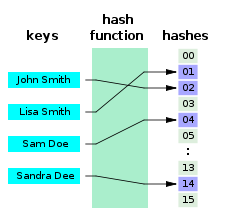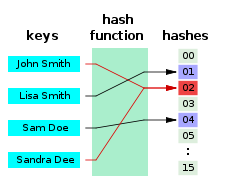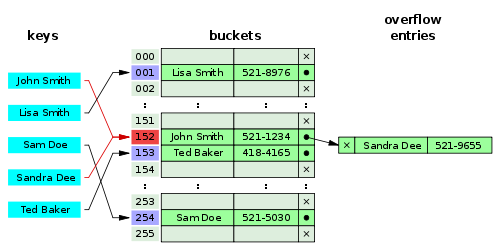Dictionaries, Hash Tables and Sets
Telerik Academy Alpha
DSA
Table of contents
-
Dictionaries
-
Hash Tables
-
Dictionary Class
-
HashSet and SortedSet
-
Advanced Data Collections
Dictionaries
What is Dictionary
- A dictionary is an indexed collection that allows values to be found by user-defined keys
- Definition - Dictionary<int, string>
- Also known as map or associative array
| Key | Value |
|---|---|
| 1 | Sofia |
| 2 | Plovdiv |
| 3 | Burgas |
| 4 | Ruse |
Why using Dictionaries
Very fast searching by key
O(1)
The Dictionary (Map) ADT
- Operations:
- Add(key, value)
- FindByKey(key)
-
Delete(key)
- Can be implemented in several ways
- List, array, hash table, balanced tree
Hash Tables
HashTable
The most efficient implementation of Dictionary
What is HashTable

Hash Tables Efficiency
-
Add / Find / Delete take just a few primitive operations
- Speed does not depend on the size of the hash-table
- Amortized complexity \( O(1) \)
-
Example: finding an element in a hash-table with 1 000 000 elements takes just a few steps
- Finding an element in array of 1 000 000 elements takes average 500 000 steps
- Speed does not depend on the size of the hash-table
Hash Tables
- A hash table is an array that holds a set of (key, value) pairs
- The process of mapping a key to a position in a table is called hashing
- A hash table has m slots, indexed from 0 to m-1
- A hash function h(k) maps keys to positions:
- \( h: k \rightarrow 0 ... (m-1) \)
- For any value k in the key range and some hash function h we have h(k) = p and 0 ≤ p < m
Example of hashing
A hash table of length 10 uses open addressing with hash function h(k)=k mod 10, and linear probing. After inserting 6 values into an empty hash table, the table is as shown below. The numbers are: 46, 34, 42, 23, 52, 33

42 mod 10 = 2
34 mod 10 = 4
33 mod 10 = 3
Hash Tables
- Perfect hashing function (PHF)
- \( h(k) \) : one-to-one mapping of each key k to an integer in the range \( [0, m-1] \)
- The PHF maps each key to a distinct integer within some manageable range
- Finding a perfect hashing function is in most cases impossible
- More realistically, hash function \( h(k) \) that maps most of the keys onto unique integers, but not all
Collisions in Hash Tables
- A collision is a situation when different keys have the same hash value
- ( h(k1) = h(k2) ) for ( k1 != k2 )
- ( h(k1) = h(k2) ) for ( k1 != k2 )

NB: When the number of collisions is sufficiently small, the hash tables work quite well (fast)
Resolving Collisions
-
Strategies
- Chaining in a list
- Using the neighboring slots (linear probing)
- Re-hashing (second hash function)

Chaining in a list:
Dictionaries in C#
Dictionary<TKey, TValue>
Type of the key
Type of the value
Task
Create collection containing information about a city's temperature
Dictionary
- Implements the ADT dictionary as hash table
- The size is dynamically increased as needed
- Contains a collection of key-value pairs
- Collisions are resolved by chaining
- Elements have almost random order
- Ordered by the hash code of the key
-
Dictionary relies on
- Object.Equals() – for comparing the keys
- Object.GetHashCode() – for calculating the hash codes of the keys
Dictionary
- Major operations:
- Add(TKey,TValue) – adds an element with the specified key and value
-
Remove(TKey) – removes the element by key
this[] – get / add / replace of element by key - Clear() – removes all elements
- Count – returns the number of elements
- Keys – returns a collection of the keys
- Values – returns a collection of the values
Dictionary
- Major operations:
- ContainsKey(TKey) – checks whether the dictionary contains the given key
-
ContainsValue(TValue) – checks whether the dictionary contains the given value
-
Warning: slow operation – \( O(n) \)
-
Warning: slow operation – \( O(n) \)
-
TryGetValue(TKey, out TValue)
- If the key is found, returns it in the TValue
Otherwise, returns false
- If the key is found, returns it in the TValue
Task
1. Update info for each city to contain population and country
2. Update population for a particular city
Task
Override Equals and GetHashCode methods
(Try the performance when they return the same value for each item)
Dictionary Demo - Student Grades
Sorted Dictionaries in C#
SortedDictionary
Dictionary with items ordered by key
SortedDictionary
-
SortedDictionary implements the ADT "dictionary" as self-balancing search tree
- Traversing the tree returns the elements in increasing order
-
Add / Find / Delete perform ( log2(n) ) operations
- Use SortedDictionary when you need the elements sorted by key
- Otherwise, use Dictionary – it has better performance
Task
User SortedDictionary to count the time each word appears in:
string text = "a text some text just some text";Note: Write on paper
SortedDictionary Demo - Word Count
Quizlet
- Which one is faster in Dictionary - searching by value or by key?
- HashTable - add/find/delete operations- do or do not depend on the size?
- What is a collision?
- ContainsValue - is or is not fast operation?
- Which element will be this one:
- Equals method is used for ...? GetHashCode() is used for ...?
- Dictionaries resolve collision by ....?
- How would those elements be ordered:
var dictionary = new Dictionary<int, string>();
dictionary.Add(1, "one");
dictionary.Add(2, "two");
dictionary.Add(3, "three");
var element = dictionary.ElementAt(1);var dictionary = new SortedDictionary<int, string>();
dictionary.Add(2, "c");
dictionary.Add(1, "a");
dictionary.Add(3, "b");Sets
Set
Keeps items with no duplicates
Bag
Keeps items with duplicates
Set and Bag ADTs
- Operations:
- Add(element)
- Contains(element) → true / false
- Delete(element)
-
Union(set) / Intersect(set)
- Sets can be implemented in several ways
- List, array, hash table, balanced tree
HashSet
Set implementation by HashTable
HashSet
- Elements are in no particular order
- All major operations are fast:
-
Add(element) – appends an element to the set
- Does nothing if the element already exists
- Remove(element) – removes given element
- Count – returns the number of elements
- UnionWith(set) / IntersectWith(set) – performs union / intersection with another set
-
Add(element) – appends an element to the set
HashSet Demo
SortedSet
HashSet with elements sorted in increasing order
SortedSet
- SortedSet implements ADT set by balanced search tree (red-black tree)
Advanced Data Structures
Wintellect Power Collections
- Wintellect Power Collections is powerful open-source data structure library
- Installing Power Collections in Visual Studio
- Use NuGet package manager

Power Collections Classes
-
Bag<T>
- A bag (multi-set) based on hash-table
- Unordered collection (with duplicates)
- Add / Find / Remove work in time \( O(1) \)
- T should provide Equals() and GetHashCode()
-
OrderedBag<T>
- A bag (multi-set) based on balanced search tree
- Add / Find / Remove work in time \( O(log(N)) \)
- T should implement IComparable<T>
Power Collections Classes
-
Set<T>
- A set based on hash-table
- Add / Find / Remove work in time \( O(1) \)
- Like .NET’s HashSet<T>
-
OrderedSet<T>
- A set based on balanced search tree (red-black)
- Add / Find / Remove work in time \( O(log(N)) \)
- Like .NET’s SortedSet<T>
- Provides fast .Range(from, to) operation
Power Collections Classes
-
MultiDictionary<TKey,TValue>
- A dictionary (map) implemented by hash-table
- Allows duplicates (configurable)
- Add / Find / Remove work in time \( O(1) \)
- Like Dictionary<TKey,List<TValue>>
- OrderedDictionary<TKey,TValue>
-
OrderedMultiDictionary<TKey,TValue>
- A dictionary based on balanced search tree
- Add / Find / Remove work in time \( O(log(N)) \)
- Provides fast .Range(from,to) operation
Power Collections Classes
-
Deque<T>
- Double-ended queue (deque)
-
BigList<T>
- Editable sequence of indexed items
- Like List<T> but provides
- Fast Insert / Delete operations (at any position)
- Fast Copy / Concat / Sub-range operations
- Implemented by the data structure "Rope"
- Special kind of balanced binary tree
PriorityQueue
A queue which elements have priority associated with it
Priority Queue
- Why using PriorityQueue
- Find the item with the highest priority
- Find the item with the highest priority
- Operations
- Enqueue (T element)
- Deque() → T
- There is no built-in priority queue in .NET
- See the data structure "binary heap"
- Can be implemented also by OrderedBag
Priority Queue Implementation
class PriorityQueue<T> where T : IComparable<T>
{
private OrderedBag<T> queue;
public int Count
{
get { return this.queue.Count; }
}
public PriorityQueue()
{
this.queue = new OrderedBag<T>();
}
public void Enqueue(T element)
{
this.queue.Add(element);
}
public T Dequeue()
{
return this.queue.RemoveFirst();
}
}Quizlet
- What is the difference between Set and Bag?
- Set or Bag has Union and Intersect methods?
- What is the Difference between SortedSet (.Net) and OrderedSet(PowerCollection)?
- Which collections do support Range(from, to)?
- What would be the order of:
- Which collections use Rope structure?
- PriorityQueue can be implemented easily with ...?
var firstSet = new SortedSet<string>(new string[] { "Alabama", "Washington", "Colorado", "New York" });
var secondSet = new SortedSet<string>(new string[] { "New York", "Alaska", "Alabama" });
var union = new SortedSet<string>(firstSet);
union.UnionWith(secondSet);Questions
[C# DSA] Dictionaries, Hash Tables and Sets
By telerikacademy
[C# DSA] Dictionaries, Hash Tables and Sets
- 1,801



